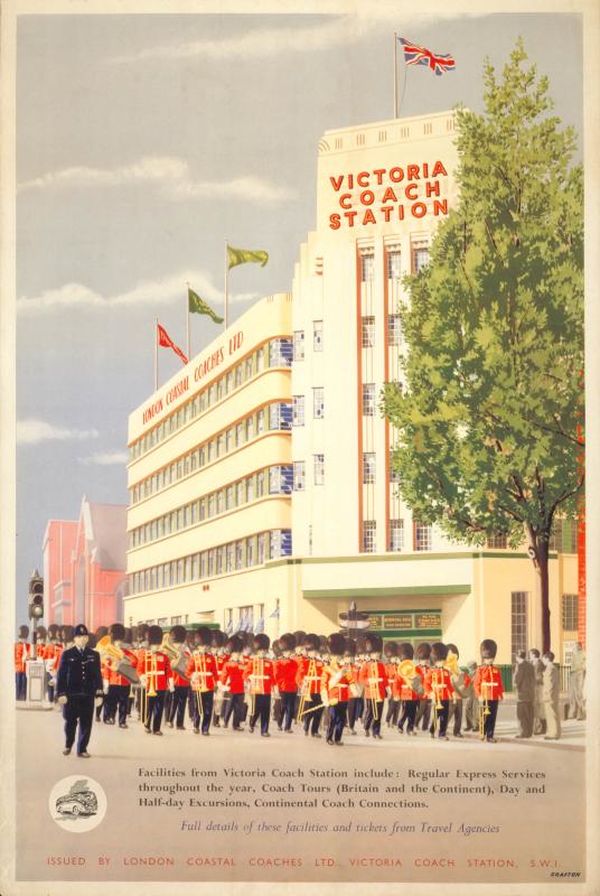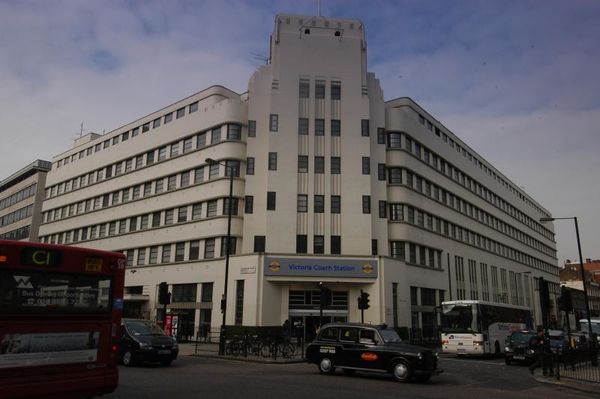
Linking London and country: Victoria Coach Station
Introduction
In 1932, the striking Art Deco building of Victoria Coach Station opened. Across the decades since, it has acted as a hub of coach travel in and out of the Capital. It has offered conducted coach tours of the sights of London, but also a variety of medium and long-range journeys connecting London to the rest of the country.
Travel by coach!
Victoria Coach Station opened at its present site on Buckingham Palace Road in 1932, run by a consortium of coach operators called London Coastal Coaches. The distinctive Art Deco building was designed by architects Wallis, Gilbert and Partners, who also created the Firestone Tyre Factory (1928) in Brentford and the Hoover Building (1933) in Perivale. As the name suggested, the operators marketed under London Coastal Coaches offered a variety of services up and down the country, particularly for leisure travel.
Victoria Coach Station opened with 66 departure bays, with the ground floor accommodating retail and refreshment facilities for coach passengers. The building was always intended to be multi-purpose, with the second, third and fourth floors leased as commercial and government offices.
Wartime and after
Coach services were interrupted by the Second World War, with all scheduled services suspended from September 1942. Victoria Coach Station also suffered bomb damage from air raids, though fortunately a bomb that directly hit the coach yard failed to explode. Services resumed in 1946, catering for a pent-up demand for rest and recreation, particularly away from bomb-scarred London. Though as these posters show, London sightseeing tours were still offered.
Expanding road travel
The 1950s saw Victoria Coach Station expand as demand increased. By the late 1950s, the site covered 2.8 acres, which represented an expansion of 40% from the original site. In 1959, with the first motorways opening, coach travel continued to grow. Further expansions of the site continued, with a new booking hall in 1961. As well as journeys throughout the country, coach tours of major sights in London and nearby were also offered, as seen in the 1950 leaflet designed by Abram Games.
Following the Transport Act of 1968, the National Bus Company was created in 1970, with Victoria Coach Station refurbished in 1972 to become its headquarters. In 1980, scheduled coach operations were deregulated, leading to Victoria Coach Station becoming swamped as the market expanded. Railway strikes in 1982 drove further passengers to coaches, contributing to a time of gridlock.
The London Transport and TfL era
After the demise of the National Bus Company, in 1988 Victoria Coach Station passed into the control of London Regional Transport, better known as London Transport, which oversaw overdue refurbishments in the 1990s. In this period London Coastal Coaches formally ceased to exist, representing the end of an era in the industry. From 1992, Victoria Coach Station was emblazoned with the distinctive Johnston font, as with other London Transport facilities.
Since 2000, Victoria Coach Station has come under the remit of London Transport’s successor, Transport for London (TfL). In the year 2019/20 around 22 million arriving and departing passengers travelled through the site. Now covering a footprint of 3.3 acres, it is the only transport facility in the UK that operates 24/7, including on Christmas Day.



















